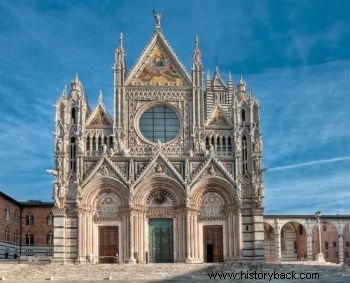The Church Medieval (or the Church in the Middle Ages) played an important role from the 5th to the 15th century .
The influence of religion was immense not only on thespiritual plane (religious power) as well as in the material domain , by becoming the largest landowner, at a time when this was the main source of wealth and political power.
During the medieval period the economy became rural, with feudalism. The Church, previously concentrated in the cities, was forced to move to the countryside, where the bishops and abbots became feudal lords.
The Church became the most powerful feudal institution, accumulating movable and immovable property through donations made by rich aristocrats who converted and by some emperors.
 Medieval church in Siena, Italy
Medieval church in Siena, Italy
In the feudal world, where society was organized on a military basis, and where the greatest qualities for the ruling classes were the warrior virtues, one of the great functions of the Church was to fight to preserve order and peace .
He instituted the Truce of God, that is, the prohibition of fighting during certain days of the month and on the main religious dates.
The medieval Church also had the function of administering justice in a number of cases, where it had exclusive jurisdiction and competence. It believed based on Canon Law, thus regulating numerous relationships and social institutions according to its laws.
Faith , was the dominant force in the life of medieval man, inspired and determined the smallest acts of everyday life.
Ethical standards were exclusively Christian, and the fear of punishment after death regulated the conduct of sinners.
Hell, with its torments, acted on the medieval imagination and its fears prevented man from sinning.
Features of the Medieval Church
In the beginning the clerical organization was simple. Each Christian community had a bishop , elected by the faithful, the priests , responsible for the teaching of religion and ceremonies, and the deacons , responsible for the administration and assistance to the population.
In the Middle Ages the priests ran the parishes , which were small districts. The various parishes formed a diocese , directed by a bishop.
Several dioceses formed an archdiocese , led by an archbishop. At the top of the hierarchy was the pope , head of the Church, successor of Saint Peter, founder of the Catholic Church.
Monastic life (monastery life) and religious orders began to emerge in Europe from 529 (6th century), when Saint Benedict of Nursia founded a monastery in Monte Cassino, Italy, and created the Order of Benedictines , giving rise to the regular clergy, that is, the clergy of the monasteries, where the monks led a life disciplined by work and obliged to obey the rules (regula , in Latin) of the order to which they belonged.
According to the rules of Saint Benedict, Benedictine monks took a vow of poverty, obedience and chastity. They were to work and pray a few hours a day and be busy with the poor, the sick, and teaching.
These rules served as a model for other religious orders that emerged in the Middle Ages, such as the Order of Franciscans , created by Saint Francis of Assisi and the Order of Dominicans , created by São Domingos de Gusmão.
The medieval Church practically had control of knowledge. The domain of reading and writing was exclusive to priests, bishops, abbots and monks.
In monasteries and abbeys were the only schools and libraries of the time. They were the main responsible for the preservation of Greco-Roman culture, with the restoration and conservation of ancient texts and were dedicated to writing religious books in Latin, the official language of the Church.
In 756 (eighth century) the Church constituted its own State, in the center of the Italian peninsula, when Pepin the Breve, king of the Franks, donated a large tract of land to the papacy, passing it to the direct administration of the Church, under the name of St. Peter's Heritage , territory that constituted the embryo of the current Vatican.
Learn more about the Middle Ages period.
Heresies and the Inquisition
Heresies were sects, factions or orientations contrary to the dogmas of the Church. At various times in the Middle Ages, groups of believers contested dogmas, being labeledheretics by the clergy.
Among the different heresies were that of the Waldensians and that of the Albigensians, both of which emerged in the twelfth century. The Waldensians preached that, to save the soul, the faithful did not need priests.
The Albigensians believed in a God of good, creator of souls, and a God of evil, who had enclosed souls in the human body to make it suffer.
Based on these principles they encouraged suicide and were against marriage to avoid procreation.
The Church waged a veritable war against heretics. Even in the 13th century she created the Inquisition , also called Court of the Holy Office , to investigate, judge and condemn heretics.
The Inquisition was responsible for the death of thousands of Jews, Arabs and Christians considered heretics.
See also:
- Medieval Culture
- Joana D'Arc
- Catholicism
- Medieval Philosophy
